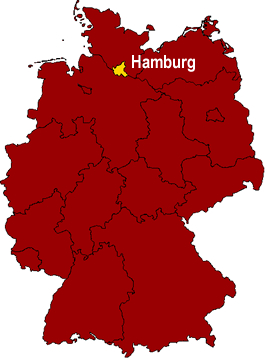Hamburg
Hamburg is a city state, meaning it is both a city and a state. With a population of 1.7 million (as of August 2006), Hamburg is Germany's second largest city, as well as the seventh largest city in the European Union. It is bordered by the German states of Lower Saxony (Niedersachsen) and Schleswig-Holstein.
The origins of the city date back to the 8th century when colonies settled on the banks of the Alster river. The city was founded in 830 and was originaly named Hammaburg.
Geographically, Hamburg lies in northern Germany, where the Elbe and Alster rivers meet. The city is 72 miles (120 km) inland from the North Sea, but it's harbor is still the second largest harbor in Europe.
Economically, Hamburg is an important city for the medicine, biotechnical, and airplane industries. Many globally known products are produced in Hamburg: Steinway pianos, Nivea skin care products, Montblanc-Füller pens.
Culinary Specialties of Hamburg
Cooking in the German state of Hamburg has been influenced by its abundant supply of seafood, as well as from its worldwide trade of spices and luxury foods. Its trade partners also brought with them cooking techniques and recipes from foreign countries.
Hamburg cooking is known for its seafood dishes. Various types of fish, crab, herring, lobster, and eel are among the favorites.
Typical seasonings used in Hamburg cooking include cayenne pepper, anise, paprika, cumin, bay leaves, cloves, saffron, curry powder, nutmeg, pepper, juniper berries, cardamom, allspice, and cinnamon.
In the Middle Ages, Hamburg had hundreds of breweries. It was in Hamburg where the discovery of hops as an ingredient to beer was made. Although many breweries still exist in Hamburg, the most well known throughout Germany is the Hosten Brewery.
A list of popular foods and dishes in Hamburg are listed below.

Photo: © Stefan Gräf - Fotolia.com

Photo: © victoria p. - Fotolia.com |
|

Districts of Hamburg
|
Hamburg is divided into seven districts, each with its own character and uniqueness. The seven districts are described briefly below.
|

Photo: © Increa - Fotolia.com
|
| Altona |
| Altona is known for its multi-cultural scene and its numerous bars, pubs, and restaurants. Its rents and housing costs are very high. Altona's closeness to the Elbe River makes it the ideal location for the Hamburg Fish Market, which takes place every Sunday. Altona is also known for its beer. The Holsten Brewery, which has been brewing beer since 1879, is located in northern Altona. |
| |
| Harburg |
| Harburg is the industrial part of Hamburg. Because of this, it is not the most picturesque part of town. The Hamburg Technical University has a campus here, so the district is a favorite of students. |
| |
| Bergedorf |
| A historic district, characterized by many traditional German timbered houses (Fachwerkhäusern) and historic churches and buildings, as well as the Bergedorf Castle. |
| |
| Hamburg Mitte |
Known as the "Heart of the City," Hamburg Mitte is a favorite destination for tourists. It is filled with site-seeing opportunities, and offers its inhabitants and visitors plenty of places to shop, eat, and drink. |
| |
| Hamburg Nord |
| Hamburg Nord is characterized by nature, industry, and transportation. The Hamburg Airport is located here, as well as, 2 large parks with many miles of walking paths, and an industrial section. |
| |
| Wandsbek |
"Small city living within the big city" is how Wandsbek can be described. It has many parks and fields, a small river flowing through town, as well as many miles of walking paths. |
| |
| Eimsbüttel |
Filled with Wilhelminian architecture and plenty of parks, Eimbüttel is a favorite of students and young families. It is known for its shopping and its numerous cafes, restaurants, and bars.
|
|

